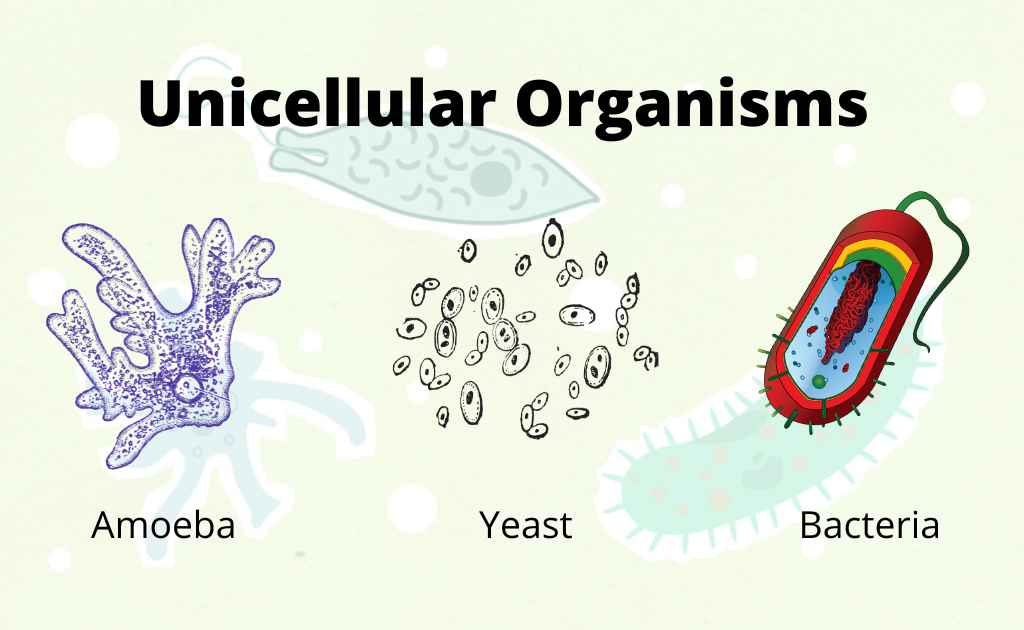Math Is Fun Forum
You are not logged in.
- Topics: Active | Unanswered
Pages: 1
#1 2024-03-24 16:53:04
- Jai Ganesh
- Administrator

- Registered: 2005-06-28
- Posts: 52,812
Unicellular Organisms
Unicellular Organisms
Gist
Unicellular organisms are made up of only one cell that carries out all of the functions needed by the organism, while multicellular organisms use many different cells to function. Unicellular organisms include bacteria, protists, and yeast.
Summary
Unicellular organisms are organisms consisting of one cell only that performs all vital functions including metabolism, excretion, and reproduction. Unicellular organisms can either be prokaryotes or eukaryotes. Examples of unicellular organisms are bacteria, archaea, unicellular fungi, and unicellular protists. Even though unicellular organisms are not seen by the naked eye, they have an indispensable role in the environment, industry, and medicine. Some of them may also be infectious or pathogenic to humans, animals, and plants.
Unicellular Definition
What is a unicellular organism? In contrast to multicellular organisms, single-celled organisms — or unicellular organisms — are groups of different living organisms consisting of one cell only. And that cell performs all vital functions, such as homeostasis, metabolism, and reproduction. Moreover, a single cell must be able to obtain and use energy, get rid of wastes, and transport materials. In contrast, multicellular organisms are made up of multiple cells and these cells have specific roles and may function together as a unit (tissue).
The cell of a unicellular organism has a protoplasm that contains various proteins, lipids, carbohydrates, and nucleic acids. The protoplasm is surrounded by a cell membrane that separates the internal components of the cell from the external environment. However, any cell should be able to interact with its external environment to obtain molecules from the outside and expel wastes to the outside.
Are bacteria unicellular? Yes! In fact, not only bacteria are unicellular but also archaea. Both bacteria and archaea are prokaryotic organisms. Unicellularity, though, is not exclusive to prokaryotes. Some eukaryotes live singly as well. Examples of single-celled eukaryotes are the unicellular algae, unicellular fungi, and protozoa.
Most living things composed of only one cell are microscopic and cannot be seen by the naked eyes. Unicellular organisms abound in nature. Even extreme habitats contain unicellular organisms. Some archaea, for instance, can survive in extreme environments, and so they are called extremophiles. They are typically resistant to extreme conditions such as temperature or pH.
Details
Unicellular organisms are organisms that have one cell. They are divided into two quite different types, from different classification kingdoms.
* The prokaryotes, bacteria and archaea, have cells with no nucleus and a simple cell structure.
* Eukaryotes have a nucleus, and a more complex cell structure.
The differences between the prokaryota and eukaryota are significant. Eukaryotes possess a nucleus and various subcellular organs called organelles, and prokaryotes do not.
Observations
Almost all unicellular organisms are microorganisms but you can observe eukaryotes and many prokaryotes by using a compound microscope. Bacteria just appear as dark dots. To gather unicellular organisms for observation, one can place a cover slip on the surface of pond water, and leave it overnight. By the next morning, numerous unicellular organisms will have grown entire colonies on the bottom of the slip. They multiply fast: colonies can double their size in between 30 minutes and a few hours.
Unicellular organisms can be found everywhere. The oldest forms of life existed 3.8 billion years ago, if not longer. They use a variety of strategies for survival: photosynthesis (cyanobacteria), chemotrophy (many archaea), and heterotrophy (amoeba). Some unicellular organisms have flagella, little tails they use for locomotion, or lobopods, extensions of the cellular skeleton (cytoskeleton), which appear as bloblike arms. The flagella of our unicellular ancestors occurs all the way up into the animals, where it makes an appearance as flagellated sperm.
Of all the six eukaryote supergroups, four are exclusively composed of unicellular organisms. Unicellular organisms vary in size, with the smallest bacteria measuring only a third of a micron (300 nanometers) across, ranging up to the titanic plasmodial slime molds, which can grow to 20 cm (8 in) across. The largest unicellular organisms may have millions of nuclei scattered throughout the cellular envelope. To observe some of the smallest unicellular organisms requires an electron microscope, while the very largest can be seen with a microscope or anything that enhances images.

It appears to me that if one wants to make progress in mathematics, one should study the masters and not the pupils. - Niels Henrik Abel.
Nothing is better than reading and gaining more and more knowledge - Stephen William Hawking.
Offline
Pages: 1